Castle AFB, CA
The B-52 low-level missions were exhilarating, requiring intense concentration from all six crewmembers for almost an hour and a half. Each of the three bombing runs started by arriving at the Initial Point (IP) on time. The IP was the last navigation point before we reached the target and the beginning of the bombing run. From there, the radar navigator provided steering data to the pilot’s display upstairs. As long as the pilot kept the two lines centered and flew the speeds we requested, the bomber arrived at the release point on time. The pre-release checklist was succinctly choreographed, with each step called out by me, the navigator, and replied to over interphone by the appropriate crewmember.

Although the B-52 (with a 185-foot wingspan) flew low to evade simulated enemy radar, the bomb release altitude was a bit higher. Seconds before the release the pilots began a short, abrupt climb. This allowed the bombs to be pitched or lobbed toward the target. Finally, the radar nav would announce, “Bombs away,” indicating the weapon had been released.
Practice Makes Perfect
During training missions, the only thing released was an electronic signal for scoring. On a real-world combat mission, a drag chute deployed on the bombs, and they would drift slowly down to the ground as the bomber escaped.
The pilots quickly changed course to the next target and pitched down to 400 feet again, creating negative Gs, and a floating sensation in the cockpit. Any unsecured objects (ink pens or my sharp pointed dividers) floated around the cockpit if we weren’t careful. It was quite a roller coaster ride! About twenty minutes later the sequence repeated itself until the final simulated bomb release. After the last “Bombs away!” call-out, instead of pitching over, the pilots continued climbing the eight-engine bomber out of the low-level route and back up to high altitude for the flight back to our base. During this climb, I would drop my mask, lean back from my tabletop, and take a long swig of water from a nearby bottle. I could finally relax a bit for the flight home.

You Had To Be At Your Best Before A Checkride
B-52 missions required detailed planning from all six crewmembers because the training route covered so much territory as the mission progressed from air refueling to high altitude bomb and missile releases to low level routes and then back to base. Planning a mission took an entire day before the actual flight.
My Heart Sank After Hearing About The Challenger Accident
My final B-52 checkride from Castle AFB was scheduled for January 29, 1986. Mission-planning day was January 28, and as we all huddled around the charts that morning, a major walked in at around 8:45 a.m. telling us the Space Shuttle Challenger had just exploded. It was a somber moment as we let the news sink in.

We were told that if we did not feel up to taking our checkride the next day it would be understandable. Although it was a terrible tragedy, we completed the planning, then headed home to watch the news updates about the shuttle explosion and the repeated scenes of the horrific mishap. Our crew knew we were well-prepared for our final evaluation, and all showed up early the next morning to fly our seven-hour checkride. By the end of January, I was a qualified BUFF Nav and my wife, Karin, and I packed up our Monte Carlo SS for the move to Barksdale AFB, near Shreveport, Louisiana.

